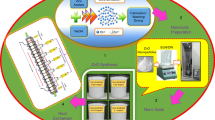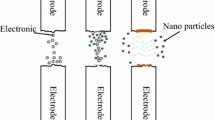Abstract
Electro discharge process has been introduced as an innovative method in production of nanosized particles in recent years. This research aimed to produce graphite nanofluid by submerged electro discharge process and evaluate the features of synthesized nanofluid, including particle size, thermal conductivity, and stability of suspension. The effects of pulse current, pulse on-time, base fluid composition, and temperature of base fluid during discharge process on the size and agglomeration of synthesized nanoparticles have been investigated. For the thermal conductivity measurement of nanofluids, a modified device based on transient hot wire technique was developed. According to metallurgical observations, the original structure of synthesized graphite nanoparticles was hexagonal and the shape of suspended particles was globular with uniform size distribution below 50 nm. Nevertheless, a low pulse on-time is strongly recommended for production of nanofluids with smaller size of particles and aggregations, along with higher stability of suspensions. The results revealed considerable enhancement in the thermal conductivity of nanofluids up to 73 % at medium temperature of 40 °C. Furthermore, the application of 1 vol% of gum acacia as surfactant provided significant stability of suspension over a long period of time even without being subjected to the ultrasonic homogenization process.
Similar content being viewed by others
References
Minkowycz WJ, Sparrow EM, Abraham JP (2013) Nanoparticle heat transfer and fluid flow. CRC Press, Taylor & Francis, ISBN: 9781439861929
Das SK, Choi SUS, Yu W, Pradeep T (2007) Nanofluids: science and technology. John Wiley & Sons Inc., p. 397, ISBN: 9780470074732
Maxwell JC (1873) A treatise on electricity and magnetism. Clarendon Press, Oxford
Das SK, Putra N, Thiesen P, Roetzel W (2003) Temperature dependence of thermal conductivity enhancement for nanofluids. J Heat Transf 125:567–574
Palabiyik I, Musina Z, Witharana S, Ding Y (2011) Dispersion stability and thermal conductivity of propylene glycol-based nanofluids. J Nanopart Res 13:5049–5055
Walvekar R, Faris IA, Khalid M (2012) Thermal conductivity of carbon nanotube nanofluid—experimental and theoretical study, heat transfer. Asian. Research 41:145–163
Yu W, Xie H (2012) A review on nanofluids: preparation, stability mechanisms, and applications. J Nanomater 2012. doi:10.1155/2012/435873
Theres Baby T, Ramaprabhu S (2011) Enhanced convective heat transfer using graphene dispersed nanofluids. Nanoscale Res Lett 6:289–298
Gupta SS, Siva VM, Krishnan S, Sreeprasad TS, Singh PK (2011) Thermal conductivity enhancement of nanofluids containing graphene nanosheets. J Appl Phys 110:1–6
Xie H, Wang J, Xi T, Liu Y (2002) Thermal conductivity of suspensions containing nanosized SiC particles. Int J Thermophys 23:571–580
Shu KM, Tu GC (2003) Study of electrical discharge grinding using metal matrix composite electrodes. International Journal of Machine Tools & Manufacture 43:845–854
Święcik R (2009) Experimental investigation of abrasive electro discharge grinding of Ti6Al4V titanium alloy. Journal of Achievements in Materials and Manufacturing Engineering 37:706–711
Ji R, Liu Y, Zhang Y, Cai B, Li H, Ma J (2010) Optimizing machining parameters of silicon carbide ceramics with ED milling and mechanical grinding combined process. Int J Adv Manuf Technol 15:195–204
R. Ji, Y. Liu, Y. Zhang, B. Cai, R. Shen, Electric discharge milling and mechanical grinding compound machining of silicon carbide ceramic. Machining Science and Technology:An International Journal, 14 (2010) 502–521.
Ji R, Liu Y, Zhang Y, Cai B, Ma J, Li X (2012) Influence of dielectric and machining parameters on the process performance for electric discharge milling of SiC ceramic. Int J Adv Manuf Technol 59:127–136
Singh S, Yadava V, Yadav RS (2014) Development and experimental investigation of electro discharge diamond face grinding, 5th International and 26th All India Manufacturing Technology, Design and Research Conference, India, p. 564
Chang H, Lin SC (2007) Fabrication method for a TiO2 nanofluid with high roundness and superior dispersion properties. Mater Trans 48:836–841
Tseng KH, Lee HL, Liao CY, Chen KC, Lin HS (2013) Rapid and efficient synthesis of silver nanofluid using electrical discharge machining. Hindawi Publishing Corporation, Journal of Nanomaterials
Loa CH, Tsung TT, Lin HM (2007) Preparation of silver nanofluid by the submerged arc nanoparticle synthesis system (SANSS). J Alloys Compd 434–435:659–662
Kassaee MZ, Buazar F, Motamedi E (2010) Effects of current on arc fabrication of Cu nanoparticles. Hindawi Publishing Corporation. J Nanomater. doi:10.1155/2010/403197
Parkansky N, Goldstein O, Alterkop B, Boxman RL, Barkay Z, Rosenberg Y, Frenkel G (2006) Features of micro and nano-particles produced by pulsed arc submerged in ethanol. Powder Technol 161:215–219
Sahu RK, Somashekhar SH, Manivannan PV (2013) Investigation on copper nanofluid obtained through micro electrical discharge machining for dispersion stability and thermal conductivity. International Conference on Design and Manufacturing, IConDM. Procedia Engineering 64:946–955
Sahu RK, Hiremath SS, Manivanna PV, Singaperumal M (2014) An innovative approach for generation of aluminum nanoparticles using micro electrical discharge machining. International Conference on Advanced Manufacturing and Materials Engineering, AMME. Procedia Materials Science 5:1205–1213
Ladjevardi SM, Asnaghi A, Izadkhast PS, Kashani AH (2013) Applicability of graphite nanofluids in direct solar energy absorption. Sol Energy 94:327–334
Sergiienko R, Shibata E, Zentaro A, Shindo D, Nakamura T, Qin G (2007) Formation and characterization of graphite-encapsulated cobalt nanoparticles synthesized by electric discharge in an ultrasonic cavitation field of liquid ethanol. Acta Mater 55:3671–3680
Xie H, Gu H, Fujii M, Zhang X (2006) Short hot wire technique for measuring thermal conductivity and thermal diffusivity of various materials. Meas Sci Technol 17:208–221
Sadri R, Ahmadi G, Togun H, Dahari M, Kazi SN, Sadeghinezhad E, Zubir N (2014) An experimental study on thermal conductivity and viscosity of nanofluids containing carbon nanotubes. Nanoscale Research Letters 9
Kennedy JF, Joaquim MSC (1993) Recovery processer for biological materials. John Wiley & Sons Ltd., ISBN 0471-93349X
Discrete semiconductors and passive electronic components. Vishay Corporation, http://www.vishay.com/
Carslaw HS, Jaeger JC (1959) Conduction of heat in solids. Oxford University Press, ISBN: 0198533683
Pastoriza-Gallego MJ, Lugo L, Legido JL, Piñeiro MM (2011) Thermal conductivity and viscosity measurements of ethylene glycol-based Al2O3 nanofluids. Nanoscale Res Lett 6:221–232
Ramire MLV, Nieto de Castro CA, Nagasaka Y, Nagashina A, Assad MJ, Wakeham WA (1995) Standard reference data for the thermal conductivity of water. American Institute of Physics and the. Am Chem Soc:1376–1381
CheHaron CH, Ghani JA, Burhanuddin Y, Seong YK, Swee CK (2008) Copper and graphite electrodes performance in electrical-discharge machining of XW42 tool steel. J Mater Process Technol 201:570–573
Shabgard M, Bavil Oliaei SN, Seyedzavvar M, Nejadebrahimi A (2011) Experimental investigation and 3D finite element prediction of the white layer thickness, heat affected zone, and surface roughness in EDM process. Springer–Journal of Mechanical Science and Technology (JMST) 25:1–11
Ojha K, Garg PK, Singh KK (2010) MRR improvement in sinking electrical discharge machining: a review. Journal of Minerals & Materials Characterization & Engineering 9:709–739
Shabgard M, Ahmadi R, Seyedzavvar M, Bavil Oliaei SN (2013) Mathematical and numerical modeling of the effect of input-parameters on the flushing efficiency of plasma channel in EDM process. Int J Mach Tools Manuf 65:79–87
Goharshadi EK, Ahmadzadeh H (2013) S. Samiee and M. Hadadian nanofluids for heat transfer enhancement—a review. Physical Chemist Researchs 1:1–33
Lo CH, Tsung TT, Chen LC, Su CH, Lin HM (2005) Fabrication of copper oxide nanofluid using submerged arc nanoparticle synthesis system (SANSS. J Nanopart Res 7:313–320
Wang XQ, Mujumdar AS (2007) Heat transfer characteristics of nanofluids: a review. Int J Therm Sci 46:1–19
Jang SP, Choi SUS (2004) Role of Brownian motion in the enhanced thermal conductivity of nanofluids. Appl Phys Lett 84:4316–4318
Author information
Authors and Affiliations
Corresponding author
Rights and permissions
About this article
Cite this article
Shabgard, M., Seyedzavvar, M. & Abbasi, H. Investigation into features of graphite nanofluid synthesized using electro discharge process. Int J Adv Manuf Technol 90, 1203–1216 (2017). https://doi.org/10.1007/s00170-016-9388-4
Received:
Accepted:
Published:
Issue Date:
DOI: https://doi.org/10.1007/s00170-016-9388-4




